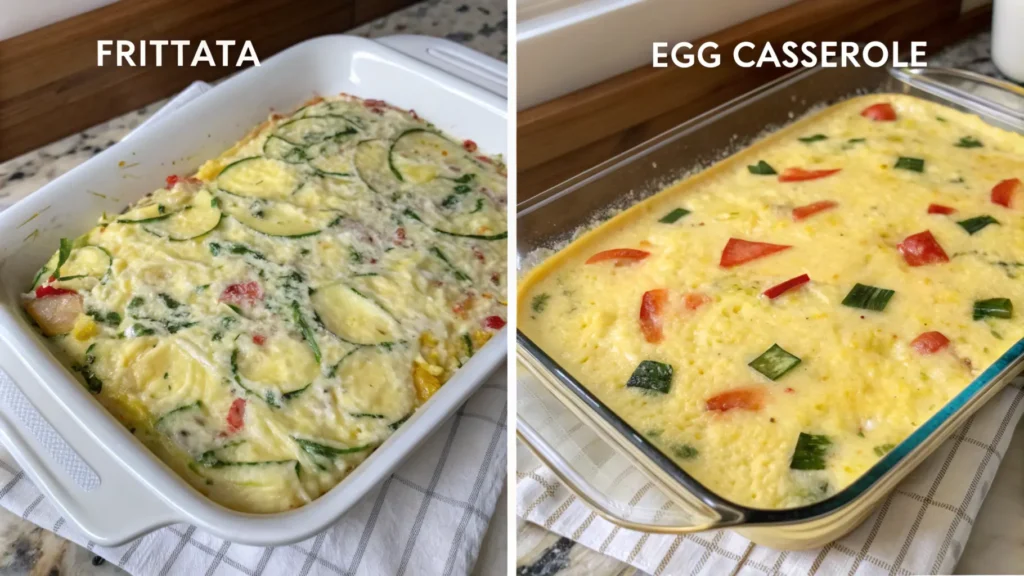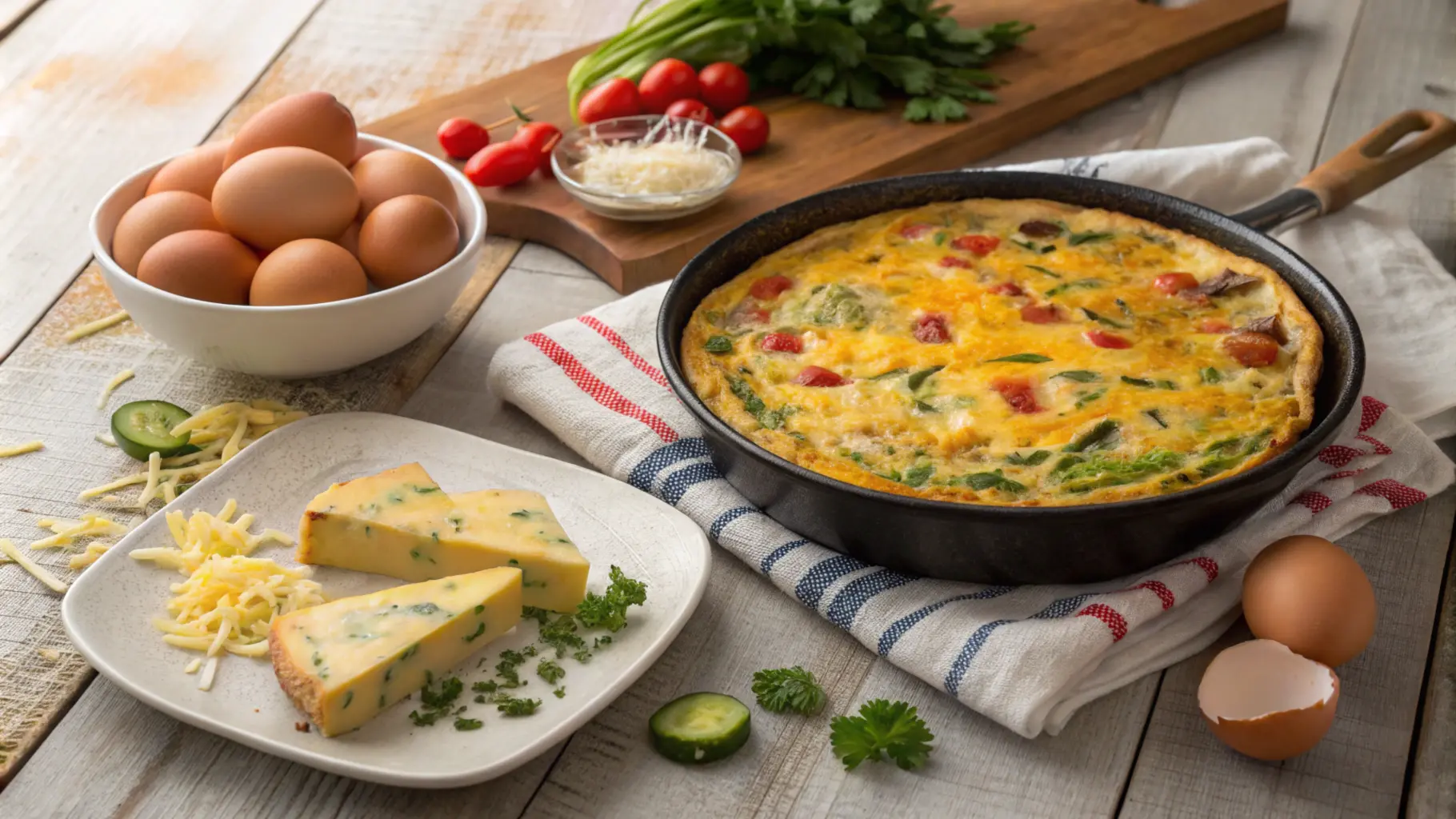The world of egg-based dishes is diverse and delicious, offering a range of options for breakfast, brunch, or even dinner. Among these, frittatas and egg casseroles stand out for their versatility and flavor. But have you ever wondered, what’s the difference between frittata and egg casserole? Understanding the difference between frittata and egg casserole is essential for choosing the right dish for any occasion.
Though these dishes share some common ingredients, the difference between frittata and egg casserole lies in their preparation, texture, and presentation. A frittata is typically cooked on the stovetop and finished in the oven, creating a light and fluffy texture. Meanwhile, an egg casserole is baked entirely in the oven, resulting in a denser, layered dish perfect for feeding a crowd.
In this article, we’ll break down the difference between frittata and egg casserole and explore expert tips, serving ideas, and recipe variations to help you master both dishes in your kitchen.
Table of Contents
Introduction to Egg-Based Dishes
Difference Between Frittata and Egg Casserole
Egg-based dishes are a staple in many households because of their versatility, simplicity, and rich flavors. Among the most popular options are the frittata and the egg casserole. However, understanding the difference between frittata and egg casserole is essential for choosing the right dish for any occasion.
Both dishes use eggs as their foundation, but the difference between frittata and egg casserole becomes clear in their texture, cooking methods, and presentation. A frittata is light and fluffy, typically cooked on the stovetop and finished in the oven. In contrast, an egg casserole is baked entirely in the oven, resulting in a denser, layered dish that’s perfect for serving a crowd.
By exploring the difference between frittata and egg casserole, you’ll gain the knowledge to create flavorful, well-balanced meals that fit any setting—from casual brunches to festive holiday feasts.
Why Compare Frittata and Egg Casserole?
You might think that a frittata is just a fancy version of an egg casserole, but they’re far from interchangeable. The cooking methods, textures, and even the occasions they suit highlight the difference between frittata and egg casserole. While the frittata leans toward Italian origins and resembles a crustless quiche, the egg casserole is a baked American classic filled with layered goodness.
By understanding the difference between frittata and egg casserole, you’ll know which dish to prepare depending on the occasion—or even your mood!
Egg dishes like these are also highly adaptable to dietary preferences. Both can easily be made vegetarian, low-carb, or gluten-free. Whether you’re a seasoned cook or just starting in the kitchen, learning the difference between frittata and egg casserole will give you the confidence to create delicious, satisfying meals.
Defining Frittata
The History of Frittata: How It Differs from Egg Casserole
The frittata has its roots in Italian cuisine, where it was traditionally created to use up leftover ingredients. The word “frittata” comes from the Italian word friggere, meaning “to fry,” which reflects its stovetop cooking method. Over time, the dish evolved into a versatile and elegant meal enjoyed around the world.
A key difference between frittata and egg casserole is their cooking method. A frittata begins on the stovetop and is often finished in the oven, resulting in a soft, custard-like texture. This gradual cooking process allows the eggs to set slowly while blending harmoniously with fresh vegetables, cheeses, and meats.
On the other hand, an egg casserole is fully assembled and baked entirely in the oven, creating a denser, heartier dish. Understanding this difference between frittata and egg casserole is essential for deciding which dish best suits your meal plans.
Key Ingredients in a Frittata vs. Egg Casserole
One of the most appealing aspects of a frittata is its flexibility. The foundation begins with whisked eggs, seasoned with salt, pepper, and herbs like parsley or chives. Fresh produce takes center stage, with additions like spinach, mushrooms, tomatoes, or zucchini adding both color and nutrition. For heartier variations, proteins such as bacon, sausage, or smoked salmon can be included, while cheeses like Parmesan, Gruyère, or feta provide a creamy, savory finish.
The difference between frittata and egg casserole becomes clear in how ingredients are incorporated. In a frittata, the fillings are blended evenly into the egg mixture, ensuring each bite delivers a perfect balance of textures and flavors. Unlike an egg casserole, a frittata contains no starchy fillers like bread or potatoes, allowing the eggs to remain the star of the dish.
Preparation and Cooking Techniques
Perfecting a frittata requires attention to both ingredients and technique. Start by heating oil or butter in a nonstick or cast-iron skillet to prevent sticking. Sauté the vegetables and proteins until tender, then pour in the egg mixture. Cook slowly over low heat to let the eggs set gradually—this ensures a soft, fluffy interior.
To finish, transfer the skillet to the oven and broil briefly until the top becomes golden and slightly puffed. This careful cooking process highlights the difference between frittata and egg casserole, as the frittata needs close monitoring to avoid overcooking. In contrast, an egg casserole bakes unattended for a longer period.
The result is a light and airy dish that’s easy to slice and serve, making the frittata perfect for breakfast, lunch, or even dinner.
Exploring Egg Casserole
The Evolution of Egg Casseroles
The egg casserole is a beloved American comfort food known for its hearty, filling nature and make-ahead convenience. It gained popularity in the mid-20th century when families began favoring easy, oven-baked meals that could feed a crowd. This dish quickly became a staple for holiday breakfasts and family gatherings.
A major difference between frittata and egg casserole is the preparation method. Unlike the stovetop-to-oven technique used for frittatas, an egg casserole is fully assembled in a baking dish and cooked entirely in the oven. This hands-off approach makes it ideal for entertaining, allowing cooks to prepare it in advance and bake it fresh when needed.
Its layered structure—often including bread, potatoes, cheese, and meats—makes the egg casserole a heartier, more filling option compared to the lighter, airy texture of a frittata. Recognizing this difference between frittata and egg casserole will help you decide which dish is better suited for your next gathering.
Common Ingredients in Egg Casseroles
An egg casserole typically begins with a rich, custard-like mixture of eggs, milk, and seasonings. To create a hearty foundation, bread cubes or shredded potatoes are often added to soak up the egg mixture. Layers of cheese, savory meats like sausage or ham, and vegetables such as peppers, onions, or broccoli add both depth and flavor.
One standout difference between frittata and egg casserole is the casserole’s adaptability. Whether you’re making a classic breakfast version with cheddar and bacon or a vegetarian option with spinach and mushrooms, the possibilities are endless. This versatility makes the egg casserole a reliable choice for different tastes and dietary needs.
How Egg Casseroles Are Typically Prepared
Preparing an egg casserole is straightforward, making it perfect for both novice and experienced cooks. Start by layering bread or potatoes in a greased baking dish. Top with your choice of fillings, ensuring even distribution for consistent flavor. Pour the egg and milk mixture over the layers, pressing gently to allow the liquid to soak through.
One of the biggest advantages of an egg casserole—and a key difference between frittata and egg casserole—is its make-ahead potential. Let the dish rest for at least 30 minutes, or overnight if possible, before baking. This resting period allows the flavors to meld and ensures the bread or potatoes fully absorb the custard. Bake until the top is golden and the center is set, usually around 40–50 minutes.
Compared to the stovetop-focused frittata, the egg casserole requires minimal hands-on time. This hands-off preparation style makes it ideal for busy mornings or entertaining guests. When considering the difference between frittata and egg casserole, this convenience is a standout feature for those who want a flavorful dish without the extra work.want a flavorful dish without the extra work.
Comparing Frittata and Egg Casserole

Texture and Consistency Differences
One of the most noticeable aspects of the difference between frittata and egg casserole is their texture. A frittata is light, airy, and custard-like because it’s gently cooked on the stovetop and finished in the oven. This slow and careful cooking method allows the eggs to stay soft and fluffy while blending evenly with fresh vegetables, meats, and cheeses.
In contrast, an egg casserole has a denser and heartier texture. Its structure comes from layering ingredients like bread, potatoes, and cheese, which absorb the egg mixture as it bakes. This process creates a firm, layered dish that holds its shape well when sliced—making it perfect for serving large groups.
Understanding this difference between frittata and egg casserole helps you choose the right dish based on the texture you prefer—whether you want something light and delicate or rich and satisfying.
Flavor Profiles: Subtle vs. Layered Tastes
The flavor profiles further highlight the difference between frittata and egg casserole. A frittata emphasizes a clean, fresh taste, allowing individual ingredients like vegetables, herbs, and cheeses to shine. It’s ideal for those who enjoy bold yet uncomplicated flavors.
On the other hand, an egg casserole offers hearty, comfort-food flavors. As it bakes, the ingredients meld together, creating a cohesive, richly layered taste. This makes the casserole an excellent choice for feeding a crowd, especially when you want something warm, filling, and satisfying.
Serving Occasions: Brunch, Breakfast, and More
While both dishes are versatile, they suit different occasions—another important difference between frittata and egg casserole. A frittata is elegant and pairs well with a light salad or fresh fruit, making it a perfect dish for brunches, casual lunches, or even picnics due to its portability.
In contrast, an egg casserole is the go-to option for holidays, family gatherings, and busy mornings. Its make-ahead convenience makes it ideal for serving large groups with minimal stress. Simply prepare it the night before, bake it in the morning, and enjoy a delicious, fuss-free meal.
Nutritional Differences and Dietary Preferences
Nutritionally, the difference between frittata and egg casserole can be significant. A frittata is typically lower in carbs because it doesn’t include starchy ingredients like bread or potatoes. This makes it an excellent choice for those following keto, low-carb, or gluten-free diets.
On the other hand, an egg casserole often includes bread, potatoes, or pasta, providing more carbohydrates and making it a more filling option for those needing extra energy. However, both dishes can be easily adapted to suit vegetarian, dairy-free, or other dietary needs, offering flexibility for any meal plan.
Culinary Tips for Each Dish
Making the Perfect Frittata: Tips and Tricks
Mastering the art of a perfect frittata requires careful attention to both ingredients and cooking techniques. To fully capture the difference between frittata and egg casserole, it’s important to remember that a frittata should be light, airy, and packed with fresh flavors.
Start by thoroughly whisking the eggs to incorporate air, which creates a soft and fluffy texture. This step is essential for achieving the lightness that sets the frittata apart.
Pre-cook any meats and vegetables to eliminate excess moisture and deepen their flavors. Slowly cook the egg mixture on the stovetop over medium-low heat, allowing the eggs to set gently without becoming dry. Once the edges firm up, transfer the skillet to the oven to finish cooking the top.
This careful stovetop-to-oven method is a major difference between frittata and egg casserole, ensuring the frittata remains light, creamy, and easy to slice. For added flavor, sprinkle fresh herbs or a dash of cheese on top before serving.
Enhancing Egg Casseroles with Unique Additions
Creating a flavorful egg casserole is all about building rich layers of taste and texture. Start by choosing a hearty base—bread cubes, shredded hash browns, or even quinoa work well to soak up the egg mixture. Then, layer in proteins like sausage, ham, or bacon, followed by vegetables and generous amounts of cheese.
Whisk the eggs with milk or cream to create a rich, custard-like mixture, and pour it evenly over the layers. Allow the casserole to rest for at least 30 minutes—or overnight—to let the flavors meld and ensure the base fully absorbs the egg mixture.
This layered, hands-off baking process highlights another key difference between frittata and egg casserole. While the frittata requires active stovetop monitoring, the egg casserole offers the convenience of make-ahead preparation and hands-free cooking, making it perfect for busy mornings or feeding a large group.
FAQs About Frittata and Egg Casserole
Can You Substitute Frittata for Egg Casserole?
Yes, but it depends on the occasion and the texture you prefer. A major difference between frittata and egg casserole is how each dish is prepared and served. A frittata cooks quickly and has a lighter, fluffier texture, making it ideal for smaller gatherings, quick brunches, or even a weeknight dinner.
On the other hand, an egg casserole is denser and more filling due to its layered ingredients like bread, potatoes, and cheese. This makes it perfect for feeding a larger group, especially during holidays or family get-togethers. While a frittata can substitute for an egg casserole in flavor, the textural and presentation differences may affect the overall dining experience.
Which Dish is Healthier?
When comparing nutrition, the difference between frittata and egg casserole becomes clear. A frittata is generally lighter and lower in carbohydrates because it doesn’t contain starchy fillers like bread or potatoes. This makes it a great option for low-carb, keto, or gluten-free diets.
In contrast, an egg casserole can be higher in calories and carbs due to layers of bread, cheese, and meats. However, it can easily be made healthier by using whole-grain bread, adding more vegetables, or opting for low-fat cheese. Understanding this difference between frittata and egg casserole allows you to tailor each dish to your dietary needs.
Do Frittatas and Egg Casseroles Freeze Well?
Absolutely! Both dishes freeze well, but there is a slight difference between frittata and egg casserole when it comes to freezing. A frittata should be cooled completely, sliced into portions, and tightly wrapped before freezing. This makes it convenient to reheat individual servings for a quick meal.
An egg casserole also freezes well, whether whole or in portions. It’s best to bake the casserole first, allow it to cool completely, then wrap it in foil for storage. For best results, thaw it overnight in the refrigerator and reheat it in the oven.
Conclusion and Recipe Ideas
Highlighting the Key Differences
In conclusion, the difference between frittata and egg casserole comes down to their preparation, texture, and how they’re served. A frittata is a lighter, quicker dish cooked on the stovetop and finished in the oven, resulting in a soft, airy texture. It’s ideal for brunches, light lunches, or even a quick dinner.
On the other hand, an egg casserole is baked entirely in the oven, offering a denser, heartier texture. Its layered structure with bread, potatoes, meats, and cheeses makes it perfect for holidays, family gatherings, or make-ahead breakfasts. Recognizing this difference between frittata and egg casserole allows you to choose the dish that best suits your event and taste preferences.
Encouraging Readers to Experiment with Recipes
Now that you understand the difference between frittata and egg casserole, it’s time to get creative in the kitchen! Whether you prefer the simplicity of a veggie-packed frittata or the comforting layers of a cheesy egg casserole, both dishes offer endless customization.
Experiment with seasonal vegetables, different cheeses, or bold spices to make each dish your own. No matter which you choose, mastering these egg-based recipes will elevate your breakfast and brunch game.

